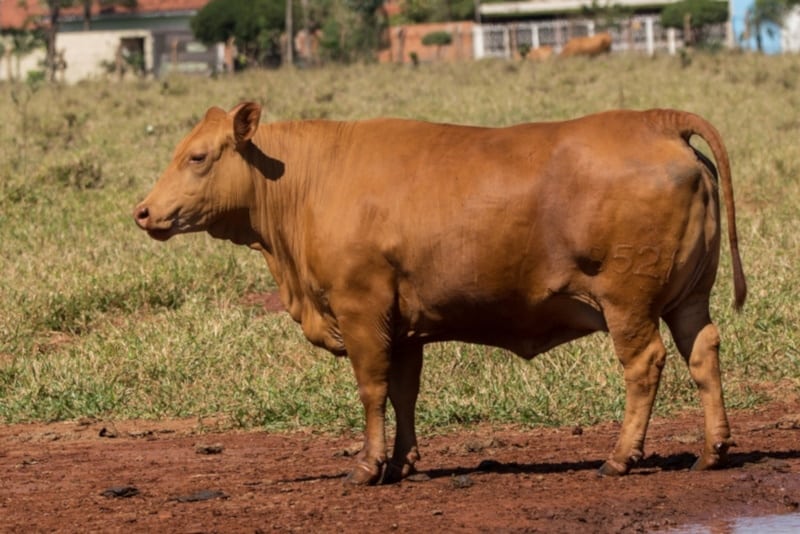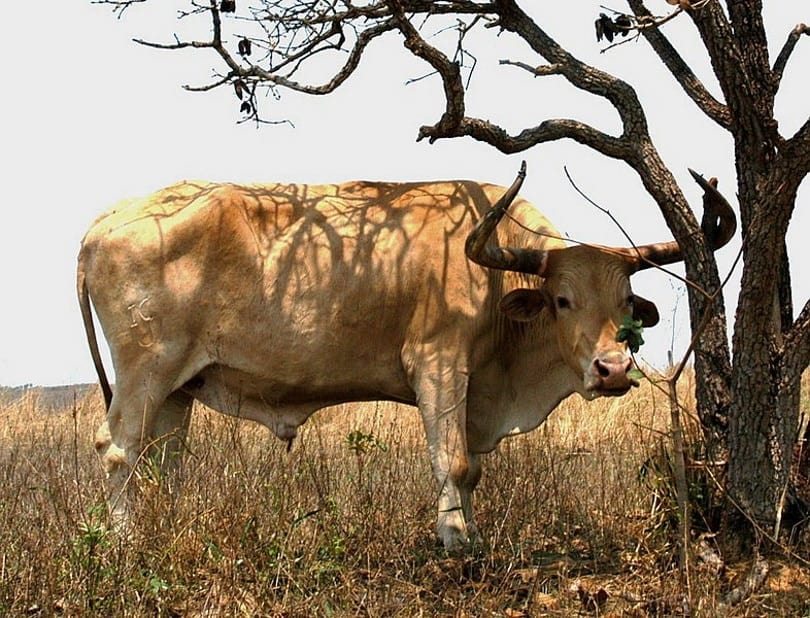Caracu is a Brazilian cattle breed that has been raised in the country since the 17th century. Although the cattle produce high-quality beef and abundant milk, most herds are used for crossbreeding and improving the genetics of other popular breeds. After several hundred years of evolution and the freedom to graze in the wild, the cattle developed a resistance to the harsh South American climate. Natural selection helped sculpt the horned cattle into one of Brazil’s hardiest breeds. Today, Caracu cattle continue to play a vital role in Brazil’s cattle industry.

Quick Facts About Caracu Cattle
| Breed Name | Caracu Cattle |
| Place of Origin | Brazil |
| Uses | Crossbreeding, beef, milk |
| Bull (Male) Size | 550–650 kilograms |
| Cow (Female) Size | 1000–1,200 kilograms |
| Color | Tan, beige |
| Lifespan | 6–20 years |
| Climate Tolerance | High heat tolerant |
| Care Level | Minimal |
| Production | High milk yield, tender beef |
| Milk fat content | 5% |
Caracu Cattle Origins
Through crossbreeding and natural selection, Caracu became a vital source of milk and beef in southern Brazil in the late 17th century. However, its roots in South America date back to the early colonization of the New World. The Caracu’s relatives, Bos Taurus Iberian and Bos Taurus Aquitanicus were the first cattle brought to Vicente, São Paulo in 1534. Portuguese settlers did not believe in confining the animals, and the cattle were able to roam freely in the wild, tropical terrain. In the late 19th century, Zebu cattle from India were brought to Brazil, and the Caracu populations came close to extinction.
Caracu Cattle Characteristics
Although the Zebu cattle’s popularity nearly eliminated the Caracu, conservation efforts managed to preserve the breed. In 1916, the Brazilian Association of Caracu Breeders (ABBC) was formed to save the cattle from extinction. Brazilian breeders and scientists maintained a small population of Caracu until 1980 when the ABBC enhanced their breeding program. They used advanced genetic manipulation and selection methods to isolate the most desired traits of Caracu so they could improve other Brazilian cattle breeds. Caracu are the largest European cattle breeds in Brazil, and their free-range history gave them several desirable traits that breeders incorporate into other cattle.
Compared to other European breeds, the Caracu adapts better to subtropical and tropical environments. They can graze and digest course vegetation that other cattle cannot tolerate, and their sturdy hulls can handle wet and dry soils. Some of the additional evolutionary advantages of the Caracu include:
- Natural resistance to ectoparasites and endoparasites
- Good posture
- Thin coat adapts better to hot climate
- Higher foreskin is ideal for dense pastures
- High fertility rate
- Cows can reproduce at 15 months old
- High success rate for birthing
- Excellent hybrid vigor
One of the Caracu’s most significant contributions to the Brazilian cattle industry is the animal’s heterosis. Heterosis, also called hybrid vigor, is the ability to pass on desirable traits like increased size, high fertility rates, and accelerated growth to its offspring. Cattle with high hybrid vigor produce characteristics in calves that are more pronounced than they were in the parents.

Caracu Cattle Uses
Brazilian ranchers raise more Nellore cattle than other breeds, and the Caracu accounts for less than 5% of the cattle used for the beef market. Caracu herds are not maintained for commercial beef and milk production but are used in crossbreeding experiments. Unlike cattle with shorter lifespans, Caracu cows can keep mating until they’re 16 or 17 years old, and they reach puberty earlier than the Nellore, Gir, and Guzerat.
Caracu cows have an exceptional maternal quality that helps their calves develop quickly, and some one-year-old calves can reach weights as high as 300 kilograms. Bulls are mated with other purebred cattle, mostly the Zebu, to improve the traits of the offspring, but they’re also used to enhance the characteristics of mixed-breed animals.
Caracu Cattle Appearance & Varieties
Most Caracu are beige or tan, but a recessive gene causes some of the cattle to have a cream-colored coat. The hoofs are lighter in color than the body, and the Caracu’s muzzle and vulva are colored light brown. Both cows and bulls can have horns, but they’re not as prominent as other long-horned varieties like the Texas Longhorn. The horns grow outward from the base of the head and slope slightly downward before curving up and growing forward. Caracu are considered medium-to-large cows, but the bulls can weigh as much as 1200 kilograms or more. Their light coat helps them tolerate the scorching climate in central Brazil, and their strong legs and hefty hulls allow them to navigate multiple terrain types. The Bull’s high foreskin enables the animal to graze in overgrown pastures without risking injuries or endangering its ability to reproduce.

Population, Distribution & Habitat
Although Brazil’s crossbreeding program has improved other cattle breeds, the purebred Caracu are not exported to other countries. Most of the Caracu population lives in central and southern Brazil. After the ABBC improved the Caracu breeding program in 1980, some cattle were kept in Minas Gerais for milk production. That led to the development of the Caracu Caldeano breed. Beginning in the early 1980s, the Instituto de Zootecnia raised Caracu to study the cattle’s benefits as a beef producer. The colder regions of Parana and Santa Catarina also raised small Caracu herds to learn how the cooler weather affected beef production of European cattle breeds.

Is the Caracu Good for Small-Scale Farming?
Caracu are highly praised for their remarkably rugged characteristics, but they’re not suitable for small-scale farming. Unlike other cattle that group together during grazing, Caracu spread out in the field and require a massive grazing area. However, South American ranchers can benefit from acquiring Caracu semen to inseminate half-breed or purebred cattle. Offspring of Caracu mixes often display higher fertility, resistance to parasites, and lower birthing mortality rates.
The Caracu breed was on the brink of extinction at the onset of the 20th century, but thanks to concerned cattle breeders and the efforts of the ABBC, the cattle’s population slowly rebounded. Very few Caracu herds are used for milk and cattle production in Brazil, but the docile creatures are a vital source for crossbreeding and improving the physiological and anatomical traits of other cattle.
Next on your reading list:
Featured Image: Caracu cattle (Image Credit: Nevinho, Wikimedia Commons, CC BY-SA 3.0)
